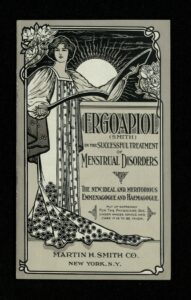– by Patrick Magee, Visitor Services/Gallery Associate

Did you like Medieval Medicine Mondays? We at the Museum did too, and it helped us gain insight into a bunch of medical oddities and trends over time! In this week’s blog entry, I want to once again shift our focus to a more recent time in medical history, one defined by printed pamphlets and a myriad of experimental drug treatments. Advertisements and texts meant for everyday people are a wonderful way to glean information about medical standards of the time and putting them into context can reveal something of a record of societal climate.
As previously discussed, the collective medical consciousness is ever evolving, and the type of treatments and solutions found during the early 20th century are quite different than the seemingly simple and superstition-informed approaches discussed previously in this blog. The 1900s saw a rise in the use of concentrates, tablets, radium and elixirs – and for a moment, one could hardly argue with the results. However, when the details of these medical concoctions and treatments are examined through the modern lens, it turns out that one generation’s cough treatment is another generation’s schedule-1 hard drug (“Drug Scheduling”).
In the Library’s Bad Medicine exhibit, there lies an assortment of informational pamphlets and advertisements claiming to point the reader in the direction of everything from a good cough treatment to menstrual disorder relief. As it turns out, the time period these works represent was defined by the use of what’s now known as narcotics – heroin for whooping cough, “carefully” dosed cocaine-inclusive mixers, and an abundance of codeine. Though the presence of these hard drugs in a medical setting will result in some head-scratching from the unfamiliar, it’s worth noting that this is the same era famous for its cocaine-inclusive cola.

Carl Koller experimented with cocaine use in 1884, and his work was able to empirically demonstrate some benefits to the drug’s presence in medicine – particularly within the field of ophthalmology. Later years gave way to the use of cocaine as anaesthesia, and though the drug proved useful in a handful of medical circumstances, its street use and abuse began to gain prevalence right alongside its increased medical use (A;, Grzybowski).
To this day, codeine cough syrup is used in cases where a cough is particularly heavy and persistent in a patient. The use of this kind of cough syrup traces back to the 1890s, during which Bayer (yes – like the aspirin!) successfully marketed heroin as a cough suppressant (History.com Editors). If you are making a connection about what ingredients are in modern cough medicine, that is astute – codeine promethazine is an opioid, putting it in a class of prescription medication that’s now tightly controlled (and certainly not marketed in cheery pamphlets).
Though codeine and morphine are still available in controlled settings, drugs like them are considered volatile and addictive enough that they are generally not prescribed as a first choice. All it can take is a higher dose or different type of use for these drugs to be deadly, which is why they are not prescribed with the frequency or ease of access found pertaining to antibiotics.
While some narcotic medications are still medically viable, others like cocaine certainly won’t be found in above-board settings anymore. Cocaine notably proved to be extremely addictive among patients and test subjects over a short period of time, creating a situation where those individuals might try to acquire more of the drug through other means after professional treatment is over. This turn to street sales and usage created a myriad of problems for communities throughout the 20th century and beyond, hence the drug’s criminalization.
Even with years of medical development, one thing remains true: many medicines are only an arm’s length away from being in the category of narcotics. To reiterate a previous theme of Medieval Medicine Mondays, every era’s doctors and scientists work within the confines of their given time period’s “normal” for the most part – and as many of the Mutter-loyal know, “normal” is ever-shifting.
Works Cited
A;, Grzybowski. [The History of Cocaine in Medicine and Its Importance to the Discovery of the Different Forms of Anaesthesia]. pubmed.ncbi.nlm.nih.gov/17687926/.
“Drug Scheduling.” DEA, www.dea.gov/drug-scheduling.
History.com Editors. “Heroin, Morphine and Opiates.” History.com, A&E Television Networks, 12 June 2017, www.history.com/topics/crime/history-of-heroin-morphine-and-opiates.
